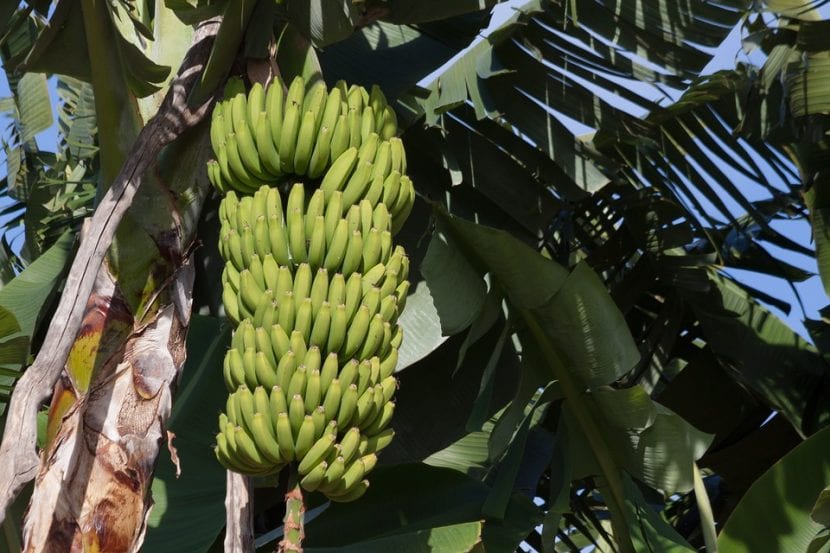
The Muses, or better known as banana trees, They are plants of the genus Musaceae. Some are known for their rich bananas, and others for their ornamental beauty, but what they all have in common is that they grow very fast. In a very few years they can reach six meters.
They are very easy to care plants, which should never be short of water, as they live near swamps and wetlands, in tropical rainforests around the world.
Origin and characteristics of banana trees
Banana trees are megaforbias, that is, giant perennial herbs, belonging to the genus Musa originating from the tropical and subtropical regions of Asia, but which have managed to become naturalized in the Middle East, Africa, America and the Mediterranean. They present a rhizomatous underground stem from which the leaves are born. These are simple, whole and generally large, with a size of up to 3 or 4 meters.
The flowers are hermaphroditic or unisexual, and are grouped in spikes or panicles with spathe. When a stem blooms, it dies, which is why at least one sucker must always be left behind, which sprouts from the rhizome. The fruits have the shape of a berry or capsule, inside which we can find -but not always- dark colored seeds.
Main species
Acuminate muse
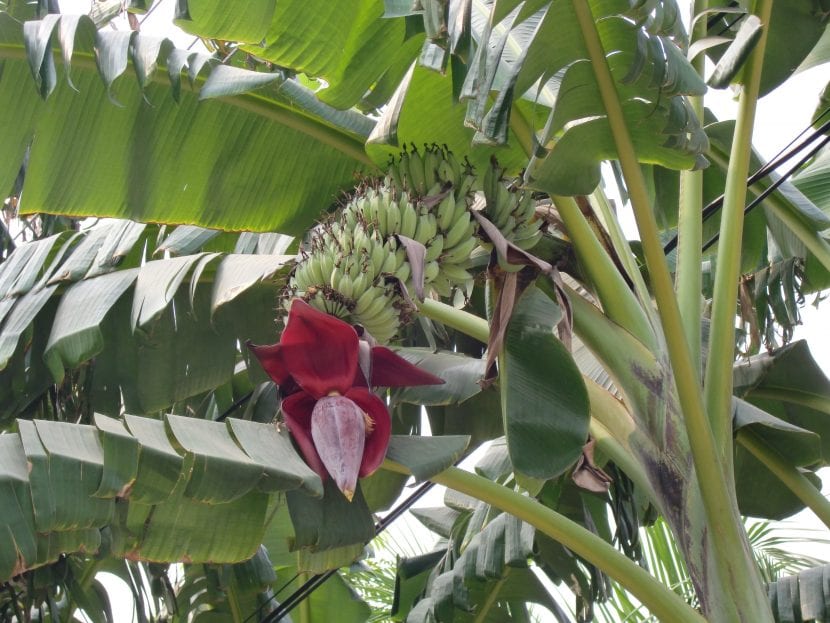
Image - Wikimedia / Miya.m
Known as the Malaysian banana or red banana, it is a native Australasian herb. It reaches a height of 7 meters, and has a tendency to produce numerous suckers from the rhizome. The leaves are long, up to 3 meters long by 60cm wide. The fruit, called plantain, is a false edible berry about 8 to 13cm long and up to 3cm in diameter., which rarely contains seeds.
It resists very weak frosts down to -2ºC once adult and acclimatized, but prefers mild, warm climates.
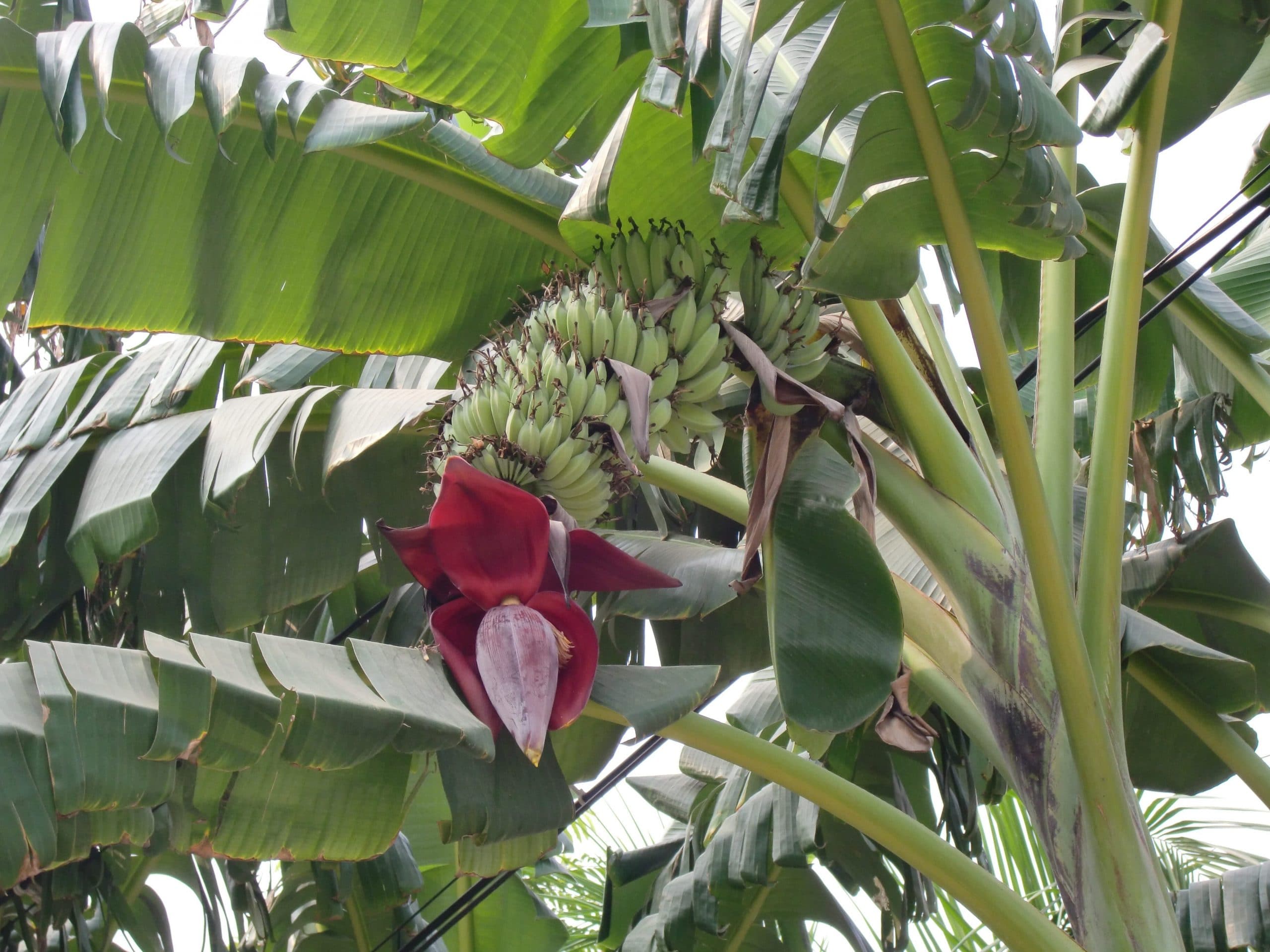
muse basjoo
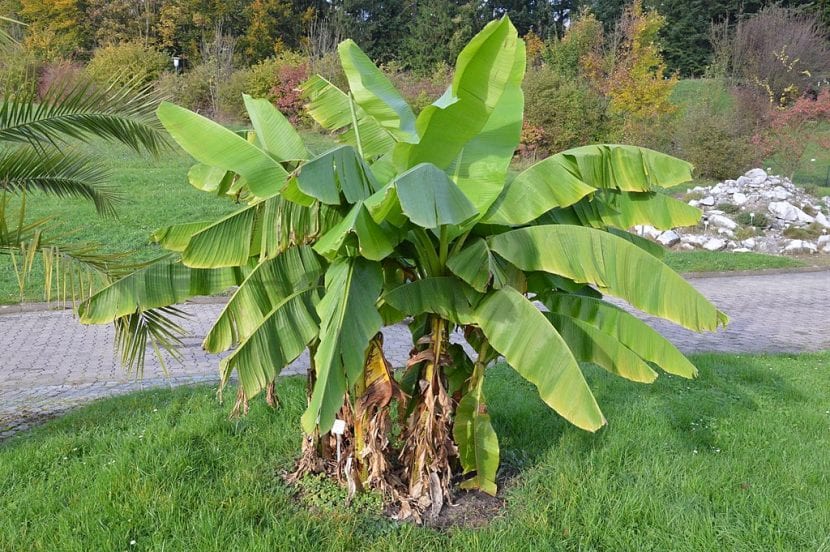
Image - Wikimedia / Illustratedjc
Known as the Japanese banana, it is a species native to southern China that reaches a maximum height of 8,2 meters, although it normally does not exceed 6m. Its leaves are up to 2 meters long by 70cm wide. The fruit is a false berry about 10cm long by 2-3cm wide, inedible.
It resists up to -15ºC, but at those temperatures only the rhizome survives if it is well protected. The aerial part (stem, leaves) is maintained as long as the temperature does not drop below -4ºC, although it may suffer damage.
Muse paradisiaca
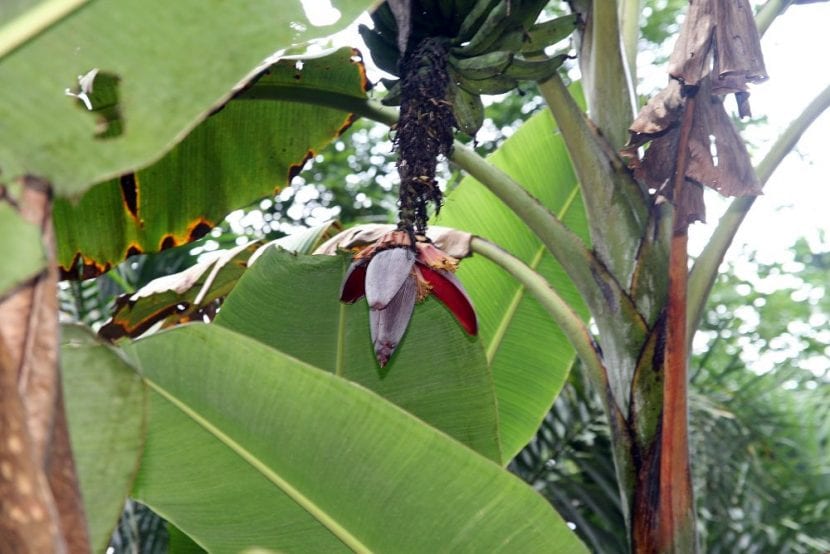
Image - Wikimedia / David J. Stang
Known as plantain, banana, banana, banana, mole or banana, it is a herb that grows to a height of 7 meters, with leaves up to 3 meters long by 90cm wide. The fruit is a false berry between 7 and 30cm long and up to 5cm wide, edible.
You don't like the cold too much. It is a plant that will grow well in tropical, subtropical, and warm temperate climates where the temperature does not drop below -3ºC.
What is the care of banana trees?

Location
To the banana trees they will have to be planted in a place in the garden where they have a lot of direct light, and where it can grow without problems. You have to think that they are plants that take up a lot of space, so it is advisable to plant them at a minimum distance of 3 meters from other tall plants.
Distance between banana trees
If we take into account its characteristics (stems up to 30cm thick, leaves up to 4 meters long, production of suckers) the ideal would be to plant them at a distance of about 6 meters. But I will also tell you that if you are going to remove said suckers, that distance may be less, 4-5m.
Earth
- Garden: in a land with good drainage. If the one we have compacts easily, we can make a hole larger than 1m x 1m, and with the earth that we have removed, we can mix it with perlite (for sale here) for instance.
- Flower pot: They are not plants that can be in pots for a long time, unless we get one of at least 60cm in diameter (at least) for more or less the same depth.
Irrigation
It needs frequent waterings, every day in spring and summer, and about four times a week in autumn-winter. In the event that it rains frequently in our area, we can water from time to time.
Subscriber
If you want to pay, recommended to use an organic compost, like guano (for sale here) or manure from some herbivorous animal (cow, horse, ...), since it is a matter of plants whose fruits are for consumption.
If a chemical fertilizer is used, it is very important to follow the manufacturer's recommendations and respect the safety period that must be left before harvesting the fruits.
We will pay them from spring to early fall.
Multiplication
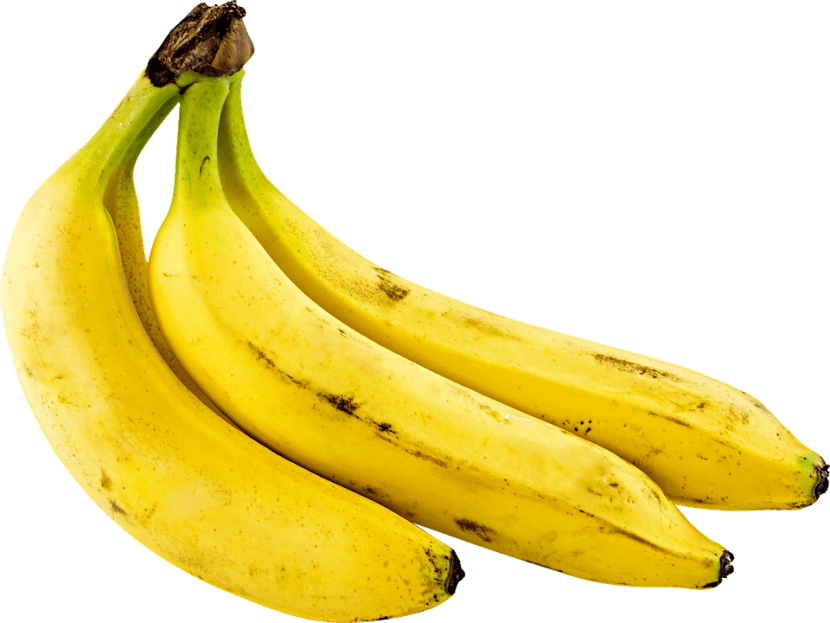
Banana trees are plants that they multiply by seeds and by suckers. Let us know how to proceed in each case:
Seeds
The seeds are sown in summer-autumn, as soon as they have been extracted from the fruits. Do not wait for spring as they have a very short viability period.
The step by step to follow is as follows:
- First, we will fill a seedling tray (for sale here) with soil for seedlings (for sale here).
- Then we will sow a maximum of two seeds in each socket.
- Next, we will sprinkle a little sulfur (for sale here) to prevent fungus.
- Finally, we will water and place the seedbed outside, in semi-shade.
Keeping the substrate always moist but not flooded, they will germinate in about 10 days.
Young
They can be separated in late spring, using a small hand saw and then planting them in other parts of the garden or in pots with universal substrate mixed with perlite in equal parts.
When to cut the bananas from the banana tree?
If they are for family consumption, we can collect them when they are yellow. But if we see that it has many, we will cut some even if they are a little green and we will wrap them with newspaper for a few days.

Rusticity
Most species of banana trees do not tolerate frost, except one, the muse basjoo, which can withstand up to -15ºC.
They can be kept near the sea, a little sheltered, but during the first two years it is possible that their leaves are damaged by the saline wind. As they are strengthened, they will produce leaves that are increasingly resistant to salt.
What are they for?
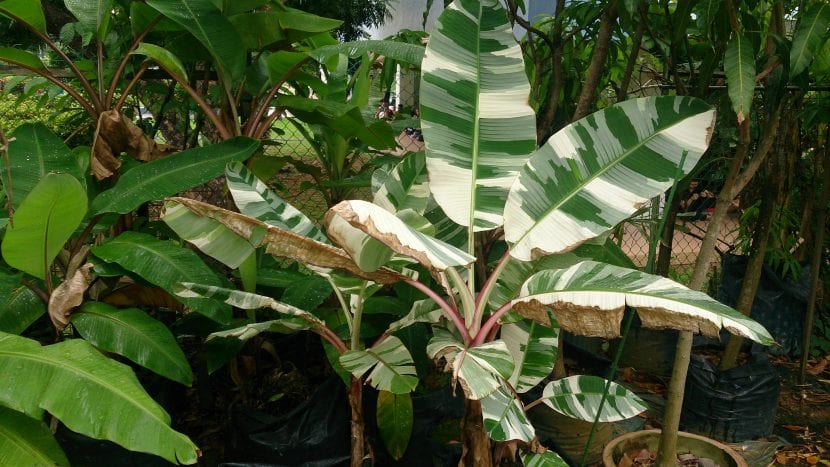
Image - Wikimedia / Mokkie // Musa x paradisiaca »Ae Ae»
Ornamental
They are very decorative plants, which bring a tropical touch to the garden. They are very easy to care for and are very grateful, since as long as they have plenty of sun and water, as well as a well-drained soil, they will grow that will be a pleasure to see them.
Edible
There are several species of Musa that produce edible fruits, such as the Acuminate muse or the Muse paradisiaca. These fruits are consumed as dessert, in fruit salads, ice cream, smoothies, juices… The nutritional value of the banana, for every 100 grams, is the following:
- Calories: 94 kcal
- Proteins: 1,2 gr
- Fat: 0,3 gr
- Carbohydrates: 20 gr
- Fiber: 3,4 gr
- Iron: 0,6 gr
- Magnesium: 38 mg
- Potassium: 350 mg
- Phosphorus: 28 mg
Other uses
It is common that in their areas of origin (and in other parts of the world) the leaves are used as an umbrella. And if that was not enough, the fibers of some species, as of the muse basjoo, are used to produce textiles.
Where to buy banana trees?
We will get them in nurseries and garden stores, both physical and online. Also here:

Musaceae is a family.
Hello!! Good Morning.
I would like to ask you a question.
I have a potted banana tree and the leaves have gone limp.
I do not know if it is due to lack of water, or otherwise, excess. The leaves are not yellow. They told me that if it is in macenta, once a week it would be fine. But here I read that almost every day ... so I don't know what to do ...
Thank you. A greeting.
Hi Alicia.
Banana trees want a lot of water. In habitat they grow near waterways, so, although they are not aquatic plants, they could be considered riverside plants.
Being in a pot, I recommend you water them every 2, or 3 days at the most.
A greeting.
After cutting the plantain ranch, what do you do with the plant? They have said that you have to cut it, but they don't tell me how to do it. Could you explain it to me? THANK YOU!!
Hello Antonio.
Yes, after cutting the bananas, you have to cut it by the foot, leaving only the stems (the suckers that come out around it).
If you have any questions, ask 🙂
A greeting.
Hello Monica.
You say that in a few years they can reach 6 meters and that you have to cut it by the foot after cutting the bananas.
My question is whether a banana tree can live for several years. Forgive my ignorance but I believed that the whole process lasted a year
.
The kings have brought me a 1,70m Canarian Paradise Muse. I have a greenhouse with heating, drip irrigation and supplementary light for the winter since it is a frost zone. I have succeeded with some citrus fruits but ... do you think I will also achieve it with the muse?
I appreciate your time and your advice in advance. A very cordial greeting and happy new year 2017
Hello Raul.
Banana trees can live for several years, what happens is that depending on the species and the area where it is grown, it is considered a seasonal plant since most do not withstand the cold.
It is very likely that you will. Add a small spoonful of Nitrofoska every 15 days to keep the roots at a comfortable temperature. This way it will better withstand the winter.
Greetings and Happy New Year.
I have several muses (near Barcelona) and with two nights below zero they have turned black. which is better to try to survive? do I cut them by the foot or do I leave them with burned leaves?
Thank you
Hello Anna.
You can cut off the parts that have turned black, and treat them with fungicide to prevent the fumes from attacking them.
A greeting.
Good morning, I have a banana tree from the Canary Islands. I have it indoors to protect it from the cold and I water it regularly. So far it was fine, strong, green leaves and new leaves coming out ... However, a week ago, I don't understand why, the leaves have started to turn yellow, and started to dry from the tips towards the inside. In fact one of them is completely dry, the other two are half; and the one that was coming out of the center has a black tip ... (I don't know if it will end up drying before leaving).
What can I do? It is in a room with light, the pot is big and has enough water since I water it 2 to 4 times a week, and I also spray it with water (when I don't water it). It has endured since November until now ... without problem. but I don't know what could be happening to him. I have changed (aired) the earth in case it was very compacted ... etc., but nothing remains the same.
Thank you and I await your response.
Hello Ruben.
From what you count it seems that your plant is suffering from excess humidity.
In winter and indoors, the soil takes longer to dry out, so I would recommend spacing more waterings. Maybe water 1 to 2 times a week, without spraying.
If you have a plate underneath, you should remove it 30 minutes after watering to remove the excess water to prevent the roots from rotting.
It is also highly recommended to do an anti-fungal treatment, to prevent, either with a liquid systemic fungicide spraying both the plant and the soil, or with copper sprinkling a little on the surface of the substrate. In the case that you have pets or children, you can treat it with natural ecological fungicides that are sold ready to use in nurseries.
A greeting.
thank you, I'll remove the water, maybe that's it ... let's see if it reverses the situation. a greeting
Good morning, I have a banana tree and it has some withered leaves. I have heard around that plants when they have leaves like this you have to cut them and not let them dry out on the plant ... I would like to know a little about this since I want to take good care of my banana tree and I do not know whether to cut this branch.
Thank you very much.
Hello Rachel.
There are opinions for all tastes heh heh. I am one of those who think that while the leaf is even yellow, it is better not to cut it because the plant is still feeding it. So if we cut it, we would force the plant in question to spend energy to close the cut.
On the other hand, if we cut the leaves that are dry, that is, brown or black, it is not a problem.
Anyway, which leaves are withered? If they are the lower ones, it is normal. The oldest ones die as the new ones come out.
A greeting.
finally it died a long time ago, I don't know if due to excessive watering, lack of watering or what, because it was perfectly fine and suddenly the leaves began to dry until they reached the stem and went to the drain.
I will try to get seeds again to see if they come out better from scratch, although of course, the plant is complicated in the nose
Good luck with the seeds. 🙂
Hello, I have a banana tree and it has thrown a bunch with four rows of bananas, they grew a little but they have stopped and they do not grow anymore. That I have to do? Thanks
Hello Monica, I have three banana trees and I have lived with them for 1 year in the area of the mountains of Toledo, the winter protected them in the garage with a breathable blanket from the k they sell to protect from the cold I put a glorente tube for plants and two k bulbs They are warm outside right now but the problem will come now in winter because they are bigger I would like you to give me some ideas to protect them this winter I also put a humidifier in winter so that everything would not be heat at about 22 ° each. How much is there to water them x I have them in a pot and also to fertilize or fertilize there is to do and make for k they are well
Hello Juan Carlos.
Well, in addition to what you have already done, I recommend you add a little Nitrofoska every 15 days now when autumn arrives and until spring (although you can continue later). With this product the roots will not feel the cold so much, so they will better withstand low temperatures.
It is also important to wrap the pot with a thermal mesh.
As for your question about watering, during the cold months you don't have to water them a lot: once or twice a week at most, with warm water.
A greeting.
Hello Monica! A couple of weeks ago I planted a banana tree in my garden (a paradisiacal muse), it was given to me by my father who owns a farm, he is the son of a very large banana tree. My intention is to have it as a decorative plant.
My question is, after it bears fruit, even if you cut the bunch and it will not give more fruit, will the plant continue to grow in height and width and will it remain a "beautiful" plant to look at, or will it die little by little ? In case the plant continues to grow ... do they last for many years?
As I said before, I have it as if it were just another palm tree in the garden, and I want to know if every so often I should cut it and leave a couple of suckers so that they grow again, or if even if it does not give more bananas it can continue to live for years with good aspect, since in a garden in my city I have seen very large, huge, and beautiful banana trees, and I highly doubt that they are less than one or two years old because of the size.
Thank you very much in advance !!
Hi Sebastian.
Banana trees bear fruit every year. To make them look pretty, you can gradually remove the dried bunches; the plant will not die 🙂, but will continue to grow.
The life expectancy of these plants is not very great, but they can live without problems for 30 years at least.
A greeting.
Hello, look I have a banana tree from a few months ago and the leaves are very yellow, I would like to know what it is due to, thanks
Hi Javier.
How often do you water it? The banana trees are not aquatic ... but they lack little 🙂. You have to water them very, very often, without fear of waterlogging the earth.
Two more questions, in your area does the wind blow more or less strong and / or regularly? Is it in the ground or in a pot? Both strong wind and unsuitable garden soil (basically the ones that compact a lot) can harm a banana tree.
A greeting.
Hello, I have a banana tree that I already put the bunch of bananas a week ago and not drying I have to remove the flower from the bananas and if I have to cut the lower part of the bunch, greetings
Hi Ruben.
No, it is not necessary to take anything from them 🙂
What is usually done is, if the bunch is loaded, remove some bananas because otherwise the weight would break the stem that connects it to the plant and all the fruits would end up wasted.
A greeting.
I HAVE TWO PLANTAINS HAS MADE ME THE FLOWERS THE FIRST ONE HOLD ME AND THE OTHERS FALL THE BUNCHES OF FLOWERS
Hi John.
I would recommend paying them, for example with guano, but chicken manure is also highly recommended (yes, if you get it fresh, let it dry in the sun for a week or ten days).
Thus they will have more strength for the flowers and, consequently, for their fruits.
A greeting.